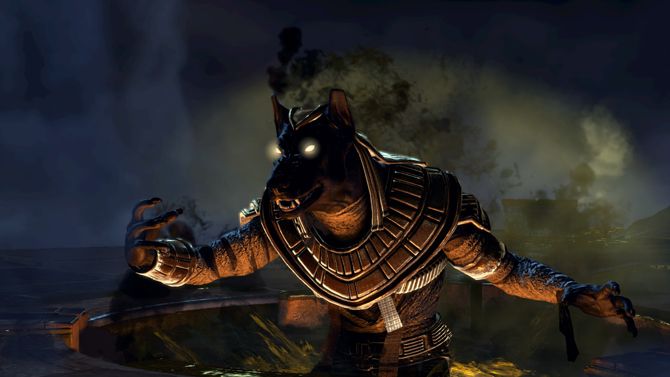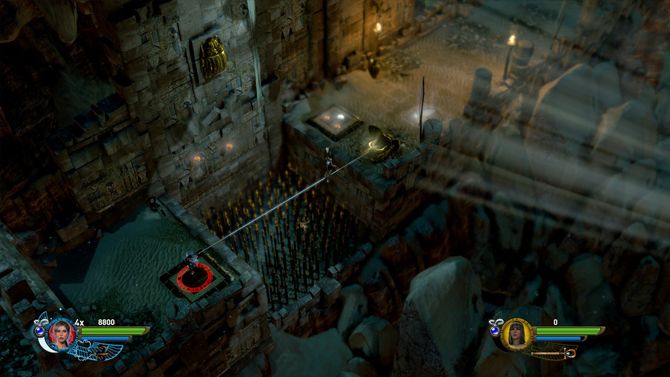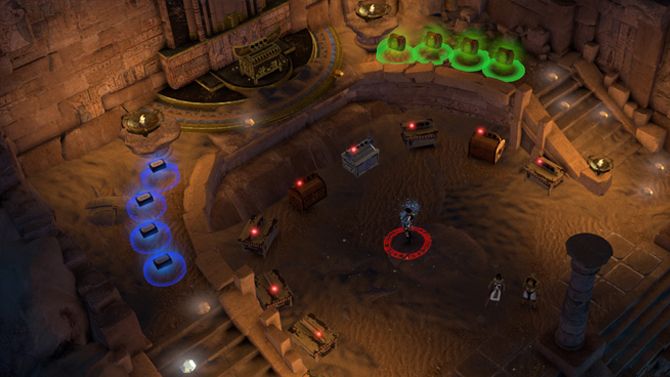Iconic video game star Lara Croft has had quite the transformation after struggling to find its footing throughout the 2000s. One of the most prominent examples was Crystal Dynamics decision to create a co-op focused, isometric digital download game that ditched the Tomb Raider moniker in 2010 called Lara Croft and the Guardian of Light.
Aided by the re-invigoration of the franchise in the 2012 Tomb Raider reboot, Crystal Dynamics has gone back down the well to provide us with more fun puzzles and action that we can now enjoy with up to four friends in Lara Croft and the Temple of Osiris.
Temple of Osiris starts out with Lara Croft and rival adventurer Carter Bell racing through an ancient temple to reach the staff of the Egyptian god Osiris. During their scramble for the priceless artifact, the pair accidentally unleashes the evil deity Set, who had diced up Osiris’ body and scattered the pieces in hidden tombs centuries ago. By awakening Set, Lara and Carter find themselves cursed to be forever chased by a giant crocodile monster named Ammit until they perish.
While this type of news would be horrible for most, thankfully by awakening Set the pair also unleashed the gods Horus and Isis, the son and wife of Osiris respectively, and are thus aided by them to restore Osiris by gathering his body parts to defeat Set and break their horrible curse.
That essentially is the entire plot of Temple of Osiris, as the game provides almost all of its exposition in the game’s starting and ending cutscenes. There is some mild banter between characters throughout the game, but most of it boils down to trite dialogue such as, "grrr, you’re evil and we’re coming for you!" Lara Croft and her pals shares little to none of the dark and gritty tones you’d expect from the rebooted Tomb Raider series, taking a much more vanilla approach in its presentation.
Fortunately, Temple of Osiris is not trying to fool anyone into believing this is a narrative driven experience. It knows that it is an arcade action and puzzle solving game, and places its emphasis on gameplay over everything else. With its isometric view and twin stick shooter controls, it provides plenty of fun when dropping bombs to blow up skeletal warriors or dousing scarab like insects with your flamethrower. Yet what is best about the game is mixing those brief moments of action with smart puzzles.
Playing solo you’ll be forced to play as Lara and will find yourself with all the game’s abilities needed to succeed, but when you add in a second player these abilities get divided between characters. When in co-op, the adventurers Lara and Carter get to use torches and grappling hooks while the gods Horus and Isis can use Osiris’ staff and create bubble force fields around themselves.
Combined use of these abilities will be necessary for success, as you’ll need to make a tight rope with your grappling hook for characters to cross chasms or the staff to raise platforms to access new areas. It is all smartly mixed and keeps everyone involved.
The tombs that hold these challenges also scale depending on your parties size, making each level feel perfectly tailored to challenge you whether playing solo or with three other friends. Unfortunately, the game’s camera doesn’t quite comply with this nearly as well and often times you'll find yourself stuck against an invisible barrier if you are too far apart from your friends, as the game forces all characters to be on the screen at the same time. This can lead to accidental deaths, but happens rarely enough that it is merely a small annoyance and not something game breaking in the grand scheme of things.
While ultimately being mechanically sound and capable of both scratching your trigger finger and flexing your mental muscles, Temple of Osiris falls flat in its endgame. You can easily breeze through the title's core story in roughly five hours, but it hopes to keep you playing by using one of video game's classic carrot on a stick designs: loot.
While running through temples you will be rewarded with gems that you can spend to open up chests that can give you loot in the forms of amulets and rings. These items can give your character bonuses like extra health regeneration or providing fire effects to your ammunition, with rings applying these enhancements to just your player character and amulets providing the effects to all players.
These items clearly are helpful and it's awesome if you can stack a fire ammunition amulet with a spread shot amulet to create a deadly combination, but it doesn’t feel great as a reward system. There isn’t anything visually that changes about your character, and while costumes are an option I never received one in a chest. Your character might be getting statistically better, but I simply did not feel compelled in any way to continue to run through tombs after the game ended to clear extra objectives or play the games one room challenge levels to gain those extra rewards.
This is also exasperated by the game’s weather effects. Throughout the course of the story, you must use a magical dial in the game's central hub location to change things like the time of day or whether or not it is snowing, in order to alter the map and reach new tombs.
While these changes are integrated well for the pace of the main campaign's progression, in the endgame its cumbersome to constantly change these conditions to reach different areas or find collectibles scattered throughout the world. While I’m sure the promise of oodles of DLC will help alleviate this, right now I’m just not drawn to playing the game past the roll of the credits.
Lara Croft and the Temple of Osiris is a great game to grab for a weekend of couch co-op with family or friends. However, you won’t find much appealing to continue to play it once you’ve defeated Set and made the world a happy place with its lackluster look system. Enjoy it for what it is, but don’t expect to invest considerable time into it.




